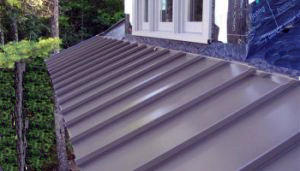Although shingled roofs are most common,  there are still a number of people who prefer a metal. A metal roof is beautiful, durable and requires little, if any, maintenance. But there are still common issues with metal roofs that we’ll explore here.
there are still a number of people who prefer a metal. A metal roof is beautiful, durable and requires little, if any, maintenance. But there are still common issues with metal roofs that we’ll explore here.
Sometimes issues occur with the metal itself, but more commonly, they are caused by improper installation or faulty manufacturing. Here are some of the most common issues with metal roofs:
Metal Roof Leaks
The most common reasons a metal roof will leak are:
- Failed screws: they are installed too loose or tight, or are off kilter, which enables water to enter the holes.
- Failed seams: the side rib connecting two panels is not seamed correctly, or is formed incorrectly.
- Failed flashing: flashing is either missing or installed incorrectly at joints such as those around the chimney, valleys or pipes.
- Failed butyl tape: butyl tape and sealants are applied to create a seal against water, dirt and debris. If they are not installed, or installed correctly, the roof could leak.
- Failure to match architectural requirements or manufacturer requirements: the metal roofing is the wrong material or the wrong size, or installation procedures are faulty.
Metal Roof Scratches
While most roofing contractors take care when installing a metal roof, improper techniques can cause scratching or scuffing. If a scratch is superficial, a touch-up paint can be applied. If it penetrates to the core, the piece of metal roofing should be replaced.Common scratching issues occur when:
- Metal coils were not protected by edge guards or the coils were wound incorrectly.
- Installers drop or rub tools against the metal panels
- Installers dent metal roof panels by walking on them, especially at areas where ladders are leaned or flashing is installed.
Metal Roof Corrosion
Although a metal roof is designed to last 60 or more years, and is manufactured with a protective paint or coating, metal is still susceptible to corrosion.
Common issues causing corrosion include:
- Dissimilar metals being placed together that can create a corrosive reaction.
- Edge creep rusting occurring at cut edges that have not been sealed. On a standing seam roof, the metal edges are folded or hemmed together to eliminate cut edges. Lap flashing or paint can also seal cut edges.
- Underside corrosion that can occur when the underside is not properly coated. When water becomes trapped, it can begin to create rust.
Metal Roof Oil Canning
Oil canning is a term used by the Metal Construction Association (MCA) to describe how light-gauge metal can buckle or “stress wrinkle,” causing a visibly wavy look to the metal.
Common issues that cause oil canning include:
- Too much pressure when it was manufactured
- Not enough space allowed for natural expansion and contraction
- Improper storage and installation
Metal Roof Chalking
When a metal roof ages, a white residue may begin to appear on its surface, called chalking or fading. This occurs when the painted coating begins to break down, which causes a change in its color. Chalking is normally caused by environmental conditions such as UV rays, air pollution, water, and chemicals.
Not Every Installer Can Do Metal Roofs
Not every roofing contractor has the knowledge or skills to install a metal roof properly. Check out your contractor before hiring them by seeking references, reading online reviews and checking county records for complaints. Ask about their experience installing metal roofs, and have them explain the different roofing options and processes.
Know your roof. Look for areas that may collect water or debris, and for areas that would require flashing. Educate yourself as to the roof pitch and slope requirements listed by a metal roof manufacturer. And don’t hesitate to question things that you feel might be out of order.
Trust Först Consulting Group
If you would like assistance in determining which type of roof or roofing material is appropriate for your home, or need help in choosing and hiring a roofing contractor, turn to Först Consulting Group. As a homeowner’s advocate, we can help you to narrow down the choices in materials and contractors, review contractors and act as a behind-the-scenes construction project manager throughout your roofing project.
If you suspect a problem with your metal roof or your roofing contractor, we can help there too by performing a professional inspection. You will receive a comprehensive report including photographs that will corroborate any claim against a manufacturer or contractor to help you fix the issues. We can also serve as an expert witness should you require legal action.
You can trust Först Consulting Group as your third-party professional inspector in the Northern Virginia and Washington DC metropolitan area. Contact us today.




